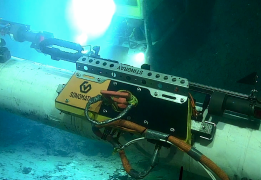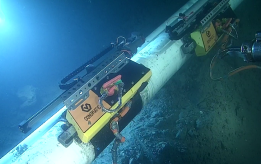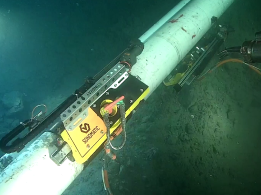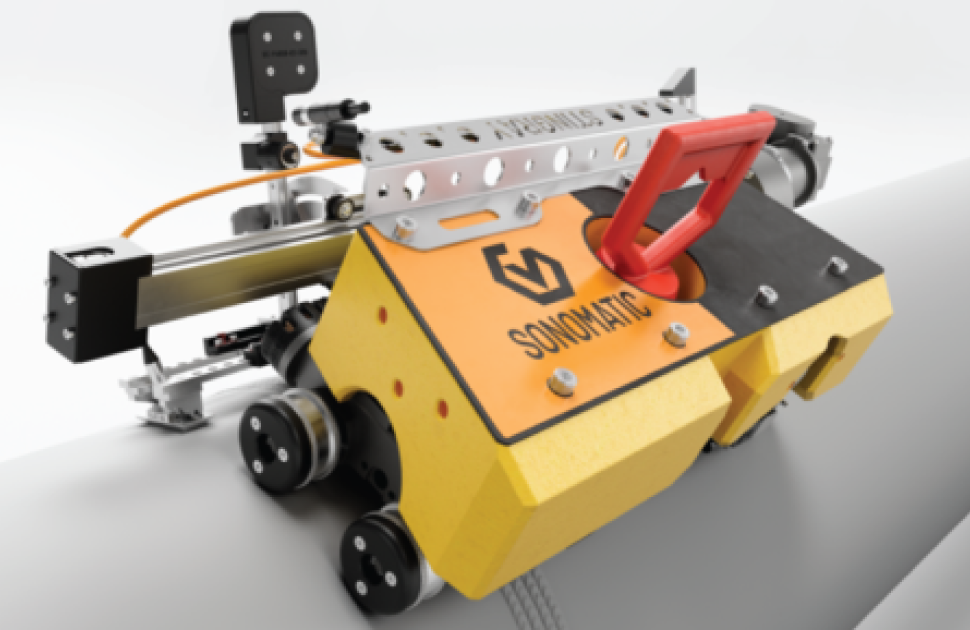DRS Magnetic Crawler
The Stingray is a low-profile, ‘high strength’ magnetic scanner used for subsea inspection of pipelines and structures such as caissons/conductors. It weighs a mere 6.5kg in water (10kg in air). The scanner is fully maneuverable using a joystick and conducts automated scanning as set by the topside operator.

When deployed via an ROV the Stingray harnesses its power supply and data communication feeds from the host ROV, making it a very versatile system.
The scanner has a short umbilical, enabling deployment in a number of challenging locations, such as inside a jacket structure to conduct structural weld inspections. The scanner is suitable for the inspection of pipelines 6” and above and can be utilized for various different applications such as TOFD/PA/UT/ACFM/DRS.
The Technology used for Stingray
In a recent application, the system was deployed with both conventional ultrasonics, and a bespoke technology called Dynamic Response Spectroscopy, (DRS), an innovative ultrasonic inspection technique for corrosion mapping through challenging coatings such as Neoprene, Polypropylene/Polyethylene, GSPU, Composite Wrap repairs, and Thermotite.
A custom DRS probe mounted on the Stingray scanner, raster across the coating surface to construct a map of the underlying steel thickness. The probe is positioned several millimeters above the inspection surface, and ultrasound is transmitted through the seawater and coating.
The probe excites the steel with a range of low ultrasonic frequencies and the steel responds, vibrating at natural frequencies related to its thickness and the local variation in thickness. Using advanced signal processing algorithms, these frequencies are extracted from the returning signals and used to determine the steel thickness at each location. A corrosion map is constructed using the frequency content of multiple A-scans.
Where delamination-type flaws exist in the coating, the signals cannot travel into the steel. DRS can identify disbandment or delamination of the coating.
Conventional UT offers accurate measurements of steel thickness based on reflections using high frequencies (5 – 10 MHz) signals and speed, distance, and time calculations. However, many coatings attenuate high-frequency signals rendering conventional UT often not possible.

DRS, however, uses lower-frequency ultrasound to make accurate measurements of steel WT as low frequencies penetrate coatings more easily. Low frequencies cause the steel to vibrate at its natural frequencies (usually < 1 MHz) and these vibration frequencies are used to calculate steel WT.
- Steel WT measurement accuracy is typically ±0.5 mm (80% tolerance).
- WT variations of <1 mm can be measured.
- Max steel WT = 22 mm (currently). However ongoing validation for 58 mm thick steel with 3-4 mm internal cladding.
- Min measurable steel WT = 3 mm (coating dependent)
- Applications of the product in the industry
One particular application required external inspection of a deepwater subsea pipeline. The challenge was that the pipeline had a 5mm 3-Layer Polypropylene (3LPP) external coating, and an injection molded polyurethane (IMPU) coating (9 mm thick) over the field joint locations, which also required inspection. The coating was not to be removed.
Onshore validation trials were conducted on a client provided ‘blanked off’ sample with numerous internal machined holes at varying depths/diameters to represent differing levels of corrosion that were anticipated to be found in the pipeline. DRS located 56, out of 60 machined defects.
Note: the image above shows signs of disbandment of the coating (white areas). Some defects were masked due to this disbandment.
On successful completion of the onshore validations, an offshore campaign commenced. In a bid to support the clients’ needs to further reduce their carbon footprint, and increase productivity, 2 scanners were deployed simultaneously, one collecting data on the 3LPP, and the 2nd scanner inspecting through the IMPU coatings at the field joints.
Benefits of Stingray to the industry and NDT professionals
There are several key benefits the Stingray scanner and DRS offer the industry:
- Lightweight for use with smaller Observation/inspection class ROVs
- Live data collection
- Strong magnetic adhesion for use on thicker coatings
- Ability to conduct cleaning and deploy several techniques simultaneously.
DRS provided a solution for the client to inspect the pipeline, without having to consider the need to remove the external coating, resulting in a lower carbon footprint, due to fewer resources required offshore.

We strive to lead the way with innovative solutions, encouraging positive challenges and change. So, we are pleased to see the progression of our subsea equipment continually being adapted to support our clients.
The Ultimate go-to-market strategy
For this job, a client we had worked for previously, reached out to us as they were impressed with the service Sonomatic provided on that project. They asked if we had the capacity to support this new project and conduct onshore validations. One of our core values is quality, we strive for continuous improvement to exceed expectations and to be known for excellence in everything we do. Practicing this on every project helps to build good lasting impressions on our clients.
In recent years we have also updated our marketing materials and website to help build our brand presence and credibility, using the platform to educate new, old, and prospective clients about our business, technology, and services to reach and form a good impression on them.
History of the company
Sonomatic specializes in the design, development, and application of Non-Destructive Testing (NDT) inspections. Since the company’s formation in the 1980s, we have combined these NDT processes with cutting-edge integrity engineering capabilities to provide fully integrated inspection packages that directly meet the client’s needs. We bring innovative bespoke inspection solutions to the market through in-house development of equipment, software, and robotics.
Sonomatic resides as the global market leader for ROV-deployed subsea inspection and Non-Intrusive Inspection (NII) technologies. Our team is committed to providing accurate, proactive inspection and engineering solutions that enable clients to make informed decisions crucial to the safe continued operation of mature assets and to manage the integrity of newly constructed ones.
Other innovative products
We have developed and adapted multiple technologies and techniques over the years. One example includes Sonomatic adapting existing subsea inspection equipment (MAG-Rover), to enable simultaneous water jet cleaning and ultrasonic PA data collection on a subsea structure. A new challenge for Sonomatic with an intense development process due to vessel operational timeframes. We completed the task at hand, successfully with all stakeholders very satisfied with the outcome.
Video and success story featured on our website here: https://sonomatic.com/subsea/structural-inspection/










